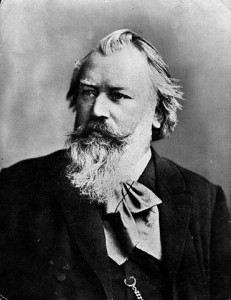 I recently posted, in both the 19th century timeline (2nd half) and the Alto Trombone Timeline, a remarkable quotation from an 1859 letter written by Johannes Brahms to his friend and fellow-musician, Theodor Avé Lallemant (Avins and Eisinger, “Six unpublished letters from Johannes Brahms” in For the Love of Music: A Festschrift in Honor of Theodore Front, Lucca, Italy: Lim antiqua, 2002). The letter has only recently been published and, as far as I can ascertain, is not generally familiar to most trombonists and trombone historians. After discussing some logistics of an upcoming performance of Begräbnissgesang, Brahms makes a firm, specific request about the instrumentation of the trombone section, a request that is of note because 1) there has been significant modern scholarly debate about performance practice and use of alto trombone in Brahms’s music; and 2) there has been some recent discussion about the use of alto trombone (or lack thereof) in the 19th century in general. Here is what Brahms says in the letter:
I recently posted, in both the 19th century timeline (2nd half) and the Alto Trombone Timeline, a remarkable quotation from an 1859 letter written by Johannes Brahms to his friend and fellow-musician, Theodor Avé Lallemant (Avins and Eisinger, “Six unpublished letters from Johannes Brahms” in For the Love of Music: A Festschrift in Honor of Theodore Front, Lucca, Italy: Lim antiqua, 2002). The letter has only recently been published and, as far as I can ascertain, is not generally familiar to most trombonists and trombone historians. After discussing some logistics of an upcoming performance of Begräbnissgesang, Brahms makes a firm, specific request about the instrumentation of the trombone section, a request that is of note because 1) there has been significant modern scholarly debate about performance practice and use of alto trombone in Brahms’s music; and 2) there has been some recent discussion about the use of alto trombone (or lack thereof) in the 19th century in general. Here is what Brahms says in the letter:
“On no account 3 tenor trombones! One genuine little alto trombone and, if possible, also a genuine bass trombone” (“Daß keine 3 Tenor Posaunen kommen! Eine ächte kleine Alt-Pos. u. wo möglich auch eine ächte Bass-Pos.”) (emphasis in original; Avins 127, 136).
(Avins and Eisinger point out, incidentally, that Brahms deliberately misspells the word echt as ächte in order to mimic the local dialect [Avins 128]).
It may be worth pointing out the similarity of Brahms’s request with that of another important composer of the era, Hector Berlioz. Less that 30 years earlier, Berlioz “demands” a “true alto trombone” for Symphony Fantastique (Trombone History Timeline–1830): “The alto trombone part must not be played on a big trombone, as is often done in France: I demand a true alto trombone.” The similarity of the adjectives is what I am drawing attention to here: “genuine” and “true” alto trombone.
The Brahms quotation would seem to suggest that Brahms may have had an affinity for the alto trombone and bass trombone. The Brahms and Berlioz quotations together would seem to indicate that the “true” or “genuine” alto trombone of that time was “little” (and not simply another tenor with a small mouthpiece; Berlioz describes it as an instrument pitched in E-flat in his orchestration treatise).
Jim Beckel
Thanks for the clarification on this subject. Over the years I have heard many different opinions about the use of the alto trombone in the Brahms symphonies. I am the principal trombonist with the Indianapolis symphony and as I get older I have greater and greater preference for using the alto when requested by the composer. The alto trombone totally works as a beautiful blend of sound within the brass section especially when the conductor insists on stylalistic authenticity.
wkimball
You’re very welcome, Jim. I’m glad there’s something there that’s useful!
Steve Shires
I am really enjoying reading these posts. As trombone players, and in my case, a trombone maker, we should also investigate the phrase from the letter “if possible, also a genuine bass trombone” . A genuine bass trombone (pitched in Eb or F) would give the section a very different sound. I think exploring a “little” bass trombone for such literature might make sense. Not a huge F or contra bass trombone, but one pitched in f with a smaller bore and bell. Thoughts?
wkimball
Yes, I completely agree. The irony is that Brahms was, at that time, advocating for a bigger instrument on the lowest part (instead of a tenor). Now, of course, bass trombones are much bigger than what Brahms was asking for.
Edward Solomon
I always suspected as much! More than any other contemporary, Brahms assiduously stuck to his guns in writing for the trombone section in a distinctly traditional manner, using separate alto, tenor and bass voices. The proof, as far as I am concerned, was in performing his symphonies Nos. 1, 3 and 4 on traditional German E flat alto, B flat tenor and F bass trombones. There is no question in my mind that the scoring is clearly conceived for the then old-fashioned ATB section of trombones, though the second symphony is more problematic, since it involves a relatively high tessitura for bass trombone and does not represent true F bass trombone writing. I’ve performed this a few times using a section of traditional E flat alto, B flat tenor, B flat/F tenorbass trombones and F tuba, which works better and more reliably (the F bass trombone becomes quite unstable above middle C and much of the second symphony lies uncomfortably high for that instrument).
wkimball
Outside of orchestration texts, it’s not that often that composers comment so specifically about instrumentation, but his request seems consistent to me. Thanks for your comment & insight!